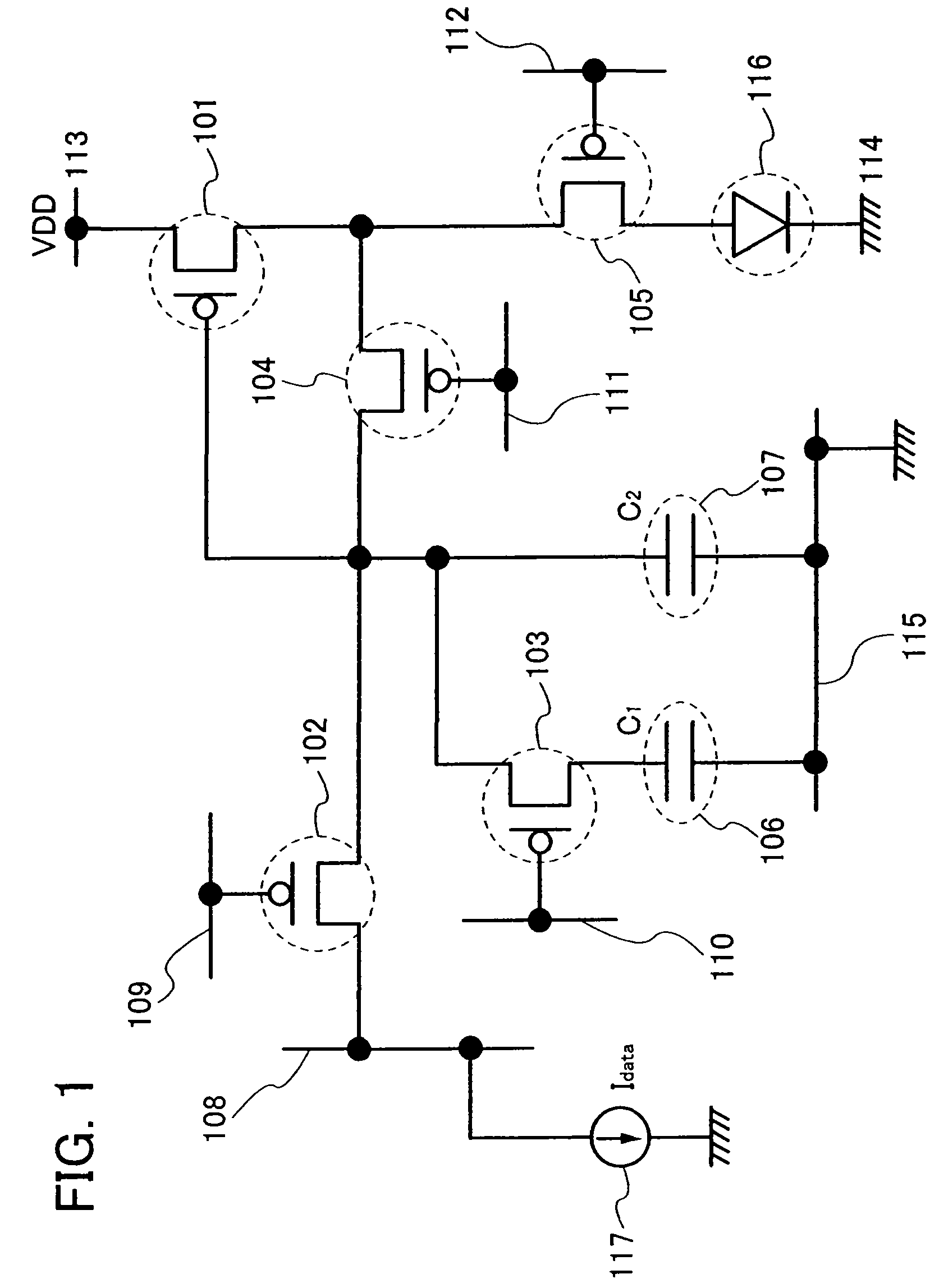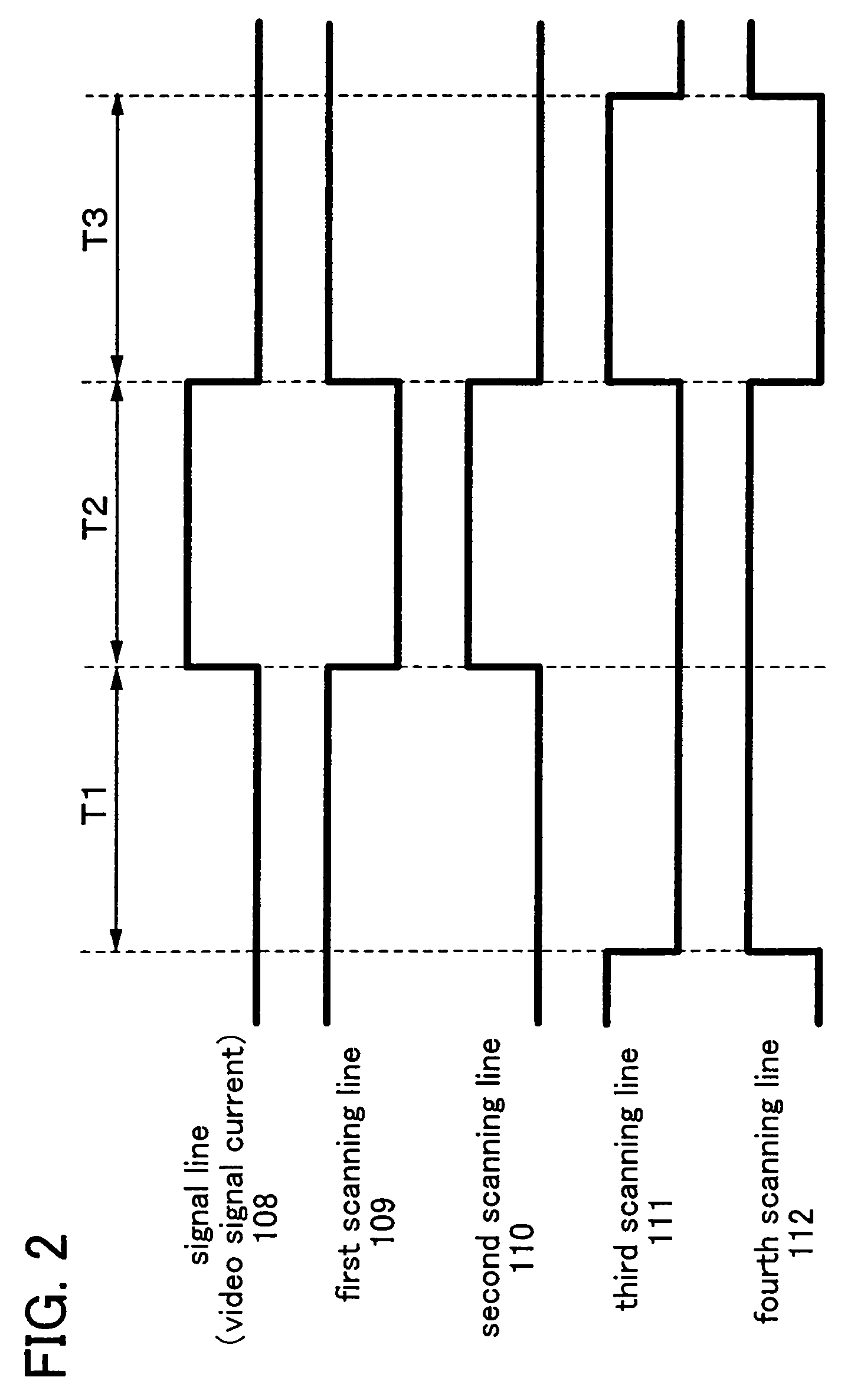Display device and driving method of display device
a display device and transistor technology, applied in static indicating devices, instruments, electroluminescent light sources, etc., can solve the problems of inability to accurately write video signals, inability to reduce the luminance of light-emitting elements, and inability to take up a lot of time, so as to improve image quality and reduce the effect of luminance variation
- Summary
- Abstract
- Description
- Claims
- Application Information
AI Technical Summary
Benefits of technology
Problems solved by technology
Method used
Image
Examples
embodiment mode 1
[0134]First, a basic structure of a pixel circuit in a display device of this embodiment mode will be explained with reference to FIG. 1. Note that the explanation will be given by exemplifying an EL element as a light-emitting element.
[0135]FIG. 1 is a diagram showing a circuit diagram of a pixel circuit of this embodiment mode. The pixel circuit of this embodiment mode includes first to fifth transistors 101 to 105, first and second storage capacitors 106 and 107, a signal line 108, first to fourth scanning lines 109 to 112, first and second power supply lines 113 and 114, a capacitor line 115, a light-emitting element 116, and a current source circuit 117. Note that the current source circuit 117 is arranged in each signal line (each column).
[0136]Note that, in the pixel circuit shown in FIG. 1, all of the transistors 101 to 105 are p-channel types.
[0137]A gate electrode of the first transistor 101 is connected to a first electrode of the second transistor 102, a first electrode ...
embodiment mode 2
[0226]Although the first and second storage capacitors are connected in parallel in Embodiment Mode 1, the storage capacitors may also be connected in series. Thus, this embodiment mode will explain a case where first and second storage capacitors are connected in series. A basic structure of a pixel circuit in a display device of this embodiment mode will be explained with reference to FIG. 17. Note that the explanation will be given by exemplifying an EL element as a light-emitting element.
[0227]FIG. 17 is a diagram showing a circuit diagram of a pixel circuit of this embodiment mode. The pixel circuit of this embodiment mode includes first to fifth transistors 1701 to 1705, first and second storage capacitors 1706 and 1707, a signal line 1708, first to fourth scanning lines 1709 to 1712, first and second power supply lines 1713 and 1714, a capacitor line 1715, a light-emitting element 1716, and a current source circuit 1717. Note that the current source circuit 1717 is arranged i...
embodiment mode 3
[0315]This embodiment mode will explain a configuration of a signal line driver circuit, a scanning line driver circuit, and the like in a display device, and an operation thereof.
[0316]For example, a display device, as shown in FIG. 1, having a pixel circuit that controls an operation by using the signal line and the first to fourth scanning lines has a configuration as shown in FIG. 62. The display device as shown in FIG. 62 has a pixel portion 6201, first to fourth scanning line driver circuits 6202 to 6205, and a signal line driver circuit 6206.
[0317]First, the signal line driver circuit will be explained. The signal line driver circuit 6206 sequentially outputs a video signal current to the pixel portion 6201 through a signal line 6211. In the pixel portion 6201, an image is displayed by controlling a state of light in accordance with the video signal current.
[0318]FIGS. 63A and 63B each show an example of a configuration of the signal line driver circuit 6206. The signal line ...
PUM
 Login to View More
Login to View More Abstract
Description
Claims
Application Information
 Login to View More
Login to View More - R&D
- Intellectual Property
- Life Sciences
- Materials
- Tech Scout
- Unparalleled Data Quality
- Higher Quality Content
- 60% Fewer Hallucinations
Browse by: Latest US Patents, China's latest patents, Technical Efficacy Thesaurus, Application Domain, Technology Topic, Popular Technical Reports.
© 2025 PatSnap. All rights reserved.Legal|Privacy policy|Modern Slavery Act Transparency Statement|Sitemap|About US| Contact US: help@patsnap.com



